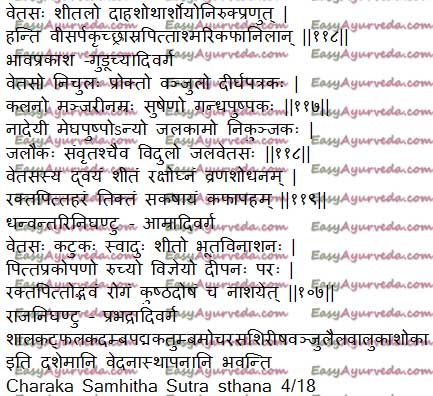Vetas (Salix caprea) – Uses, Indications, Dose, Side Effects, Research
By Dr Renita D’Souza
Vetas (Salix caprea) is an Ayurvedic herb used to treat bleeding diseases, renal calculi, fever, rheumatic pain, gastrointestinal problems, vaginal pain, wounds, skin diseases etc.
Botanical Name – Salix caprea Family – Salicaceae, Vetasa Kula
Varga – Panchavalkala
Table of Contents
Home remedies, vernacular names
Vernacular Names of Salix caprea
Sanskrit Name – Vetasa
Hindi Name – Bed mushk
English Name – Goat willow, Great sallow
Uses of Salix caprea
- Due to Grahi (absorbent) quality of bark of Salix caprea it can be used in diarrhea, malabsorption syndrome.
- Bark is said to possess analgesic, diuretic, cardio tonic and aphrodisiac qualities .
- Its leaves possess antipyretic properties. Hence it can be used to bring down high body temperature.
- Flowers of vetas is used to improve taste as it possess ruchya quality.
- The distillate from its flowers (arka) is used in tachycardia and fever caused due to excess heat. In case of eye infections and headache, the cloth soaked in distillate is kept locally. In the Unani system of medicine it is used in the name Arka bed mushk.
- Bark paste is used in piles.
- Due to salicin content in the bark of Salix caprea it is mainly used as a pain relieving agent and used to treat osteoarthritis, rheumatic arthritis, headache, gout, menstrual cramps etc.
- In Rheumatic arthritis use of bark decoction helps to relieve joint swelling, burning sensation, joint stiffness and pain.
- It is also used in wounds, cut and bleeding diseases due to its astringent property.
- In Vishama and Pittaja fever its bark decoction is used internally.
- It can also be used to wash wounds or cuts. It stops the bleeding, reduces swelling, burning sensation and inflammation.
- Bark decoction gargle is used in sore throat.
Qualities, action, uses
Medicinal Qualities Of Vetasa
Rasa (taste) – Tiktha (bitter), Kashaya (astringent) – (D.N)
Swaadhu (sweet) – (R.N)
Vipaka (taste after digestion) – Katu (pungent)
Virya (potency) – shita (cold)
Karma (action)
Bhuta vinashana (wards off evil spirits or psychiatric diseases caused by evil spirits)
Deepana – kindles digestive fire Ruchya – improves taste
Indications
Daha – Burning sensation
Shotha – Inflammation
Arsha – Piles
Yoni ruk – vaginal pain, gynecological disorders
Visarpa – Herpes
Mutrakrichra – painful urination, difficulty to pass urine
Rakta pitta – bleeding disorders
Ashmari – renal calculi
Vrana shodhana – cleanses the wound and helps in fast healing
Kusta – skin diseases
Effect on Doshas Balances Kapha and Vata dosha
Part used, dose, side effects
Part used Bark, Leaves, Flowers
Dosage
Decoction – 50 – 100 ml in divided dose per day Powder – 5 – 10 grams in divided dose per day Flower distillate – 12 – 20 ml
Side Effects of Salix caprea There are no recorded side effects. Seek medical advice for its usage in pregnancy and lactation. High dose and prolonged use can cause stomach irritation and constipation. Salicin compounds in its bark act as aspirin which has analgesic, antipyretic and anti inflammatory properties hence it is better to avoid in patients allergic to aspirin and should be taken with caution in patients with Kidney disease..
Morphology, controversy, pharmacology
Morphology of Salix caprea It is a small tree growing at a height of 8 – 10 meter. Leaves are 5 – 10 cm long, alternate, ovate to obovate in shape, toothed margins, dark green above, gray and short -hairy beneath. Flowers are silvery catkins. Fruit is a small hairy capsule with numerous small seeds embedded in the hairs. Flowers yield essential oil.
Controversy regarding identification of Vetas herb There are different herbs mentioned as vetasa by different authors – Calamus tenuis – Salix caprea – Salix alba The qualities of Salix caprea resembles the qualities of Vetas herb mentioned in Bhavaprakasha Nighantu.
Pharmacological Activities of Ved mushk Antipyretic, Anti inflammatory, Analgesic, Anthelmintic, Anti bacterial, Haemostatic, Sedative
Distribution, chemistry, research
Salix caprea is found in Europe, Western and Central Asia. In India it is found in Kashmir and Punjab.
Chemical constituents of Salix caprea Carbohydrates, tannin, steroids, phenolglucosides,vitamins, alkaloids, flavonoids such as rutin (rutine), cynaroside, quercetin, and luteolin, Salicin, salicartin, salireproside etc
Research
Anti inflammatory Activity – A research study conducted to evaluate the anti inflammatory activity of Salix caprea flowers by HRBC membrane stabilization method have proved its potent anti inflammatory activity. Read more about different species of willow and its Use
Sanskrit verse

Interaction with medicines, supplements
Can this be used while taking Homeopathic medicine?
Yes. This product does not react with homeopathic medicine.
Can this medicine be continued while taking supplements like multivitamin tablets, Omega 3 fatty acids etc?
Yes. Generally, this product goes well with most dietary supplements. However, if you are taking more than one product per day, please consult your doctor for an opinion.
With western
medicines
Seek your
doctor’s advice if you are taking this product along with other western
(allopathic / modern) medicines. Some Ayurvedic herbs can interact with modern
medicine.
If both Ayurvedic and allopathic medicines are advised together, then it is
best to take Allopathic medicine first, wait for 30 minutes and then take the
Ayurvedic medicine.
Categorization
Classical categorization Charaka Samhitha – Vedanasthapana Ghana Bhavaprakasha Nighantu – Guduchyadi Varga Dhanvantari Nighantu – Amraadi Varga Raja Nighantu – Prabhadraadi Varga
Sanskrit synonyms of vetasa
Namraka, Vaanir Vanjula Abhrapushpa Vidula, Ratha Shita
Click to Consult Dr Renita D’Souza
Sthanika karma (Systemic Action)
External – Reduce pain and burning sensation. Indicated in Eye diseases, headache. Its bark decoction can be used externally to reduce pain, burning sensation and bleeding in Hemorrhoids.
Internal administration
Nervous System – Reduce pain, good for boosting brain function. Indicated in headache, joint pain etc.
Digestive system – Act as carminative and absorbent. Indicated in low appetite, malabsorption syndrome
Circulatory System – Act as styptic, improve heart function, indicated in bleeding disorders
Respiratory System – Being Astringent in taste it promote wound healing, and indicated in breathing difficulty, hemoptysis, chest injury
Excretory System – Act as diuretic, indicated in urinary calculi, dysuria
Reproductive System – Indicated in female reproductive disorders – weakness of uterine muscles and ligaments. Also indicated in impotence, erectile dysfunction
Skin – Indicated in Kushta, Visarpa (Various skin disorders)
Tapakrama – Reduce fever and burning sensation. Indicated in fever due to pitta and in vishama jvara








